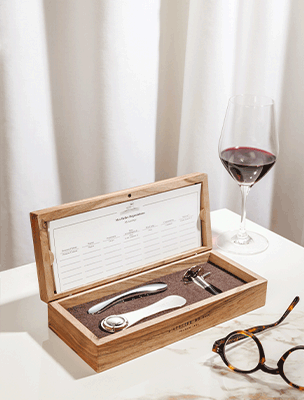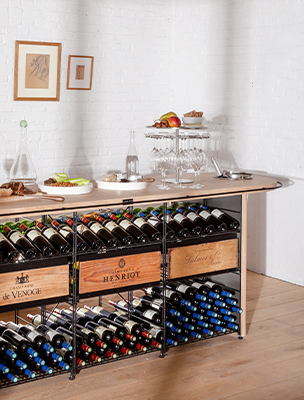
Wine is more than just a drink—it represents a way of life that unites, inspires and celebrates culture. For wine enthusiasts, cultivating a vineyard is a fulfilling adventure, a way to get back in touch with nature while creating one’s own wine. Imagine the pleasure involved in producing, with your own hands, the very nectar that will fill your glasses. So, are you ready to dive into the world of winemaking and tend your own grapevines?
- The grapevine: the essence of your future wine
- The essential steps for maintaining your vineyard
- Protecting your vineyard: an essential undertaking
- La Harvest and post-harvest: the crowning moment of all your winemaking labor
- Indispensable tools for maintaining your vineyard
- The joy of cultivating your own vineyard
The grapevine: the essence of your future wine
Grapevines are more than just simple plants—they are the soul of your future wine. Belonging to the Vitaceae family of flowering plants in the genus Vitis, they come in an incredible diversity of varieties, with nearly 200 in France alone. Each variety possesses its own unique flavors and aromas to discover:
- Merlot, Cabernet Sauvignon, and Sauvignon Blanc (Bordeaux): richness and elegance.
- Chardonnay and Pinot Noir (Burgundy): refined and subtle nuances.
- Syrah and Grenache (Rhône): intense, complex flavors.
- Malbec (Southwest): robust, profound notes.
- Gamay (Beaujolais): lively, fruity aromas.
- Riesling (Alsace): unique freshness.



Each variety has its own identity shaped by the terroir—a unique mix of soils (sand, pebbles, schist, limestone, clay, etc.) and climatic conditions (sun, temperature, rain, humidity, etc.). Cultivating your own grapevines allows you to play with these elements to create wines that reflect your own personal style and passions.
Our tip: Take the time to get to know each variety to see if it’s suited to your environment.
With these basics, you’re now ready to transform your passion for wine into an exciting personal project. Keep reading to find out how to tend your vines and obtain grapes of exceptional quality.
The essential steps for maintaining your vineyard
Cultivating a vineyard is a rewarding activity, but a few key steps need to be followed to ensure a quality harvest. Each gesture counts if you want your plants to end up producing optimal grapes.
Planting: the foundation of your vineyard.
To get off to a good start, you’ll need to choose a sunny location oriented to the south or southwest and sheltered from the wind. If you don’t have a yard or small plot of land, grapevines can also be cultivated in plant pots to provide a natural touch to any balcony or terrace. In colder regions, be sure to mulch your vines in winter to protect them from frost.
Young plants, which are often called “bare-root plants” during their first year, are more vulnerable and require extra attention. Here are some recommendations:
- Mediterranean region: planting from February to June
- Cold regions: from April to June
- Other regions: from March to June
Maintain a distance of at least one meter between each vine trunk. Before planting, remove all weeds from the area. Dig a hole 16 inches (40 cm) wide by 16 inches (40 cm) deep, add some fertilizer pellets, cover them with some soil, place your plant in the hole, fill the hole back in, and water generously. Now, let nature take its course and savor each moment!
Our tip: For optimal care, make sure you have the right tools before you begin! Check out our selection to find out what you need to get off to a good start.
Planting vine stock on your property may be subject to approval from local authorities depending on the region.
Pruning: the art of sculpting your vines
Pruning is an essential part of keeping your grapevines healthy and ensuring the quality of your harvest. It allows you to control how your plants grow and encourages the production of larger and sweeter grapes. Pruning is done mostly in winter when the vines are dormant, but summer pruning can also be done.

Here are three techniques you need to be familiar with:
- Cane pruning: Conserves the canes (from the previous season) and the spurs (shorter sections of wood) for a balanced distribution.
- Spur pruning: The short branches and spurs are spaced regularly, thus creating a harmonious structure.
- Gobelet trained: A traditional method in Mediterranean regions, this technique maintains three to five arms with two to three buds each, thus shaping the plant like a goblet.
The purpose of pruning is to the remove unnecessary branches and concentrate the grapevine’s energy into producing quality grapes. Successful pruning ensures generous bunches perfect for memorable tastings.
Watering: maintaining a proper water balance
Sufficient watering is crucial for your grapes to attain an optimal concentration of sugars and aromas. The first year, your vines will require 6 liters of water every two to three weeks to nurture root growth. From the second year onwards, a proper irrigation system is recommended.
Two common irrigation methods:
- Drip irrigation: Economic and efficient, it ensures that a regular and controlled amount of water reaches the vines.
- Sprinkler irrigation: This can be done using a traveling sprinkler (not recommended due to water loss) or sprinkler units close to the ground (more efficient, but they require monitoring to prevent damage).
Choosing the right irrigation system ensures you’ll have robust vines and abundant harvests.
Fertilization: nourishment equals better harvests
To achieve healthy vines and quality grapes, using fertilizers adapted to your soil, climate, and grape variety is a must. Organic fertilizers such as compost and manure enrich the soil and stimulate the growth of microbial life. Apply during planting and after each harvest.
Chemical fertilizers (NPK formulas) provide specific nutrients to the soil and must be applied every six months. Slow-release fertilizers in the form of pellets, which slowly release nutrients, are ideal for large plantings and varied climates.
By following these steps, you’ll be able to effectively maintain your vineyard and fully enjoy each step of your winemaking adventure, from the first planting to the final harvest.

Protecting your vineyard: an essential undertaking
Seeing your vineyard suffer is a heartbreaking experience for any wine enthusiast. Fortunately, solutions exist to protect your plants from diseases and pests so that they remain robust and productive. Here are the main threats to watch out for and how to neutralize them efficiently.
Common diseases
Diseases can quickly transform a vineyard into a nightmare. Here are the most common diseases to be familiar with so that you can fight them better:
- Mildew: Dreaded in ocean regions, this parasitic fungus turns leaves yellow and grape bunches brown, causing them dry up.
- Botrytis: Known as “gray rot”, this fungus causes leaves to turn yellow and the berries brown, negatively affecting the flavors, aromas and fermentation of the grapes.
- Powdery mildew: Called the “white powder disease”, this mildew appears as white spots on leaves and branches and leaves a grayish powder on the bunches, causing the berries to split.
Treatment and prevention
Simple treatments exist for each disease:
- For mildew: spray a solution of warm water, bicarbonate and soft soap on the affected areas. Use fungicides such as chlorothalonil for added protection.
- To combat oïdium: Spray a mixture of sodium bicarbonate (baking soda) and cooking oil on the affected areas.
- For botrytis: Apply Serenade Max®, a Bacillus subtilis-based fungicide, up until the day before harvesting for effective protection.

Preventive measures
Prevention is still the best medicine:
- Limit your use of nitrogen-rich fertilizers in order to avoid excessive growth.
- Make sure your vines get a lot of air by trellising, bud-thinning and eliminating some leaves to reduce dampness.
- Opt for resistant grape varieties and spray them with a stinging nettle or algae extract to strengthen the vines’ natural defenses.
- Eliminate infected bunches and leaves after each harvest to prevent the spread of diseases.
Protecting your vineyard is job requiring much dedication. By caring for your plants, you’ll ensure abundant harvests of quality grapes and, above all, the incomparable pleasure of savoring a wine you made yourself.
Harvest and post-harvest: the crowning moment of all your winemaking labor
After months of carefully tending your vines, the time to harvest your grapes has finally arrived! This step is crucial for determining the quality of your wine. Take the time to thoroughly plan your harvest so as to optimize the fruits of your labor.
The harvesting period: time to harvest

In France, harvesting generally takes place from August to October depending on the region and climatic conditions. The key to choosing the right moment depends on the grapes’ firmness, color, aroma, and flavor. Certain winemakers user cutting-edge techniques such as chemical analyses and digital imaging to precisely determine the best time to harvest.
There are two main harvesting methods:
- Hand harvesting: This traditional method is a precise way to select the best grapes, thus guaranteeing superior-quality wines.
- Machine harvesting: This quicker method is appropriate for large plots, but it isn’t suitable for steep terrain or tight rows of vines.

Tending your vineyard after the harvest: preparing the vines for the following year
There’s still work to be done after the harvest. The vines will become dormant, and it’s important to prepare for the coming season. Begin by pre-pruning unnecessary vine shoots to reduce the size of the vine stock so that the plants can conserve their energy for the following spring.
Also remember to perform maintenance on the soil by aerating it and removing weeds. Finally, make sure you add essential nutrients such as nitrogen, phosphoric acid, and potassium to the soil to keep it balanced and fertile.
Indispensable tools for maintaining your vineyard

Maintaining your vineyard will require the use of tools specifically designed for each step of the process. Using the right equipment will allow you to work more efficiently while enjoying your winegrowing experience to the fullest. Here are the essential tools you’ll need to pamper your vineyard throughout the year
- Pruning shears : This essential pruning tool enables you to cut the vine shoots and train your vines for optimal growth. Quality pruning shears make clean cuts to minimize the stress on your plants.
- Pruning cart or stool: Indispensable for long days spent maintaining your vines, a cart or stool allows you to work comfortably by reducing leg and back fatigue.
- Stakes and rope: These are used to keep your vines straight and properly aligned, especially when they grow fast. The rope supports the vines and keeps them from bending in the wind or under the weight of large grape bunches.
- Wire and wire tensioners: Facilitating the vertical growth of your vines and improving air circulation are essential for preventing diseases and making harvesting easier.
- Protective equipment: Protect yourself with gardening gloves, safety boots and ear muffs to work safely without injuries.
Our tip: FELCO has all the essential tools you’ll need to enjoy the experience of expertly maintaining your vineyard.
The joy of cultivating your own vineyard
By cultivating your own vineyard, you’ll get to reconnect with nature while making your own wine. Imagine spending summer nights surrounded by friends while enjoying a wine you made yourself… what a memorable experience that would be!
L’Atelierhttps://www.atelierduvin.com/en/product/latelier-du-vin-x-felco/ du Vin and Felco have come together to offer the Vine to Garden collection, a reflection of the natural link between winegrowing traditions and toolmaking expertise. Inspired by the Richard family’s Champagne heritage, this range of tools designed for wine enthusiasts provides elegant precision during each step of the vine-tending process.

Want to bring this passion home? Discover our selection of accessories for equipping your wine cellar and livening up your tasting events so that you can truly savor shared moments such as these.
Copyrights.
Editorial, visual and graphic elements strictly linked to copyrights. For any request of partial or total use, contact us.




